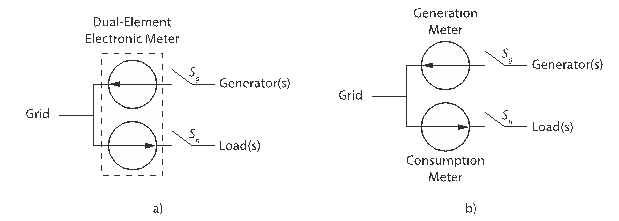Amidst all the action around grid connected rooftop PV systems, it is important to understand the type of metering and how that would impact your generation based incentives. This article aims to provide some clarity on the topic.
The type of meter that will be installed with a grid-connected PV system will depend on the purchasing agreement with the electricity distributor. Two types of widely used metering arrangements are net metering and gross metering:
1. Net Metering
In net metering arrangement, the meter is allowed to operate in both directions. The electricity produced by the PV system (Sg) either provides power directly to the loads or is exported to the grid making the meter rotate backwards, reducing the actual number of units consumed as counted by the meter (Figure 1.1).
When information is required on both the export and import electricity, a dual metering system is used. In this arrangement two mechanical meters can be installed with i-dents that only allow them to operate (or rotate) in one direction only (Figure 1.2). In this arrangement, the export meter will record the amount of electricity generated by the PV system that is exported to the grid during the day, while the import meter will record the exact amount of electricity that is consumed from the grid. By setting the export price of generated electricity at appropriate levels, users can be incentivized to increase self-consumption.

Figure 1.1

Figure 1.2
2. Gross Metering
This type of metering measures the generation and import of your electricity separately. By metering the total number of solar units of generated and total number of units consumed, this method allows the utility to charge the customers separately for import, generation and net consumption and if required, even at different rates. This is imposed by having two separate meters or using dual metering (dual-element electronic import and export meter; Figure 2). However, in this type of configuration, all of the energy generated is exported to the grid and user has no incentive to increase self-consumption.

Figure 2
Learn about more such topics, best practices and international standards in GSES ‘Grid Connected PV Systems Design’ online course or read more in GSES ‘Grid Connected PV Systems Design and Installation’ Handbook. Visit www.gses.in/training or www.gses.in/publications for details.
Buy now using your credit or debit card on the GSES online shop (www.gses.in
/shop).
Follow us on Facebook, Twitter and LinkedIn for more such updates.
Copyright GSES India Sustainable Energy Pvt. Ltd 2024